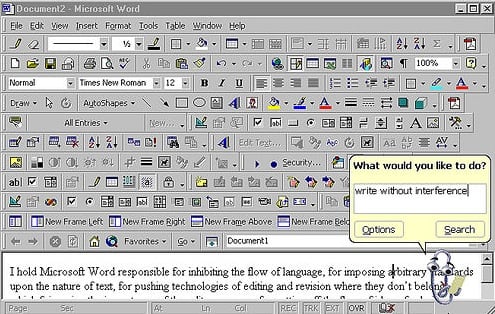You have /5 articles left.
Sign up for a free account or log in.
Lesley McCollum is PhD student in neuroscience at the University of Alabama at Birmingham. You can follow her on Twitter @lesleyamccollum.

I’m writing this post in Microsoft Word. Chances are, it’s where you do a lot of your writing as well. It’s easy, convenient, familiar, and gets the job done for simple text documents. There are a lot of great features to MS Word if you want to (or have to) stick with it for your writing. If so, check out our previous post by Hanna on quick tricks for formatting in Word.
Some tasks call for a bit more than a basic word processor, though. If you’ve ever spent too many frustrating hours trying to format a Word document with multiple tables and figures (why does my figure keep moving halfway off the page?!), then you will likely agree that it’s not always the best to work with. As I embark on the dissertation-writing journey, I have been looking for an alternative to MS Word that is up for the job—something that can handle a large multi-chaptered document with robust formatting options.
The ideal software would be cheap (preferably free), fairly quick and painless to learn, and compatible with a reference/citation manager. One barrier to changing software is that my mentor likes using MS Word to edit my documents with the track changes feature. So a bonus would be that files could easily be converted to .docx to ease sending them to my PI for reviews. Here are a few non-Word options I have come across in my search for the best dissertation-writing software that seem to be favorites:
Windows, Mac OS X, Linux/Unix
Cost: free
LaTeX is an open-source document preparation system that was designed for scholarly and technical writing, and is great for handling large documents. It is a powerful and highly customizable typesetting system that, in contrast to MS Word, separates the content and document design. LaTeX is a markup language—it’s not exactly a programming language, but it does have similarities to coding. Because of this, there is definitely a learning curve when starting out. I was first exposed to LaTeX during college and used it to write my undergraduate thesis. It did take a while to learn, but has a huge amount of document support, and a great online community to answer just about any question you come across. The features I found that really made it worth the effort were its phenomenal job at handling mathematical equations, tables, and figures, and its own powerful reference manager BibTeX. Because it was designed to be used with LaTeX, they integrate perfectly and handle citations and cross-referencing effortlessly. One downside is that LaTeX does not export to .docx file format, so if you need a Word document for revisions or submission, there is no streamlined conversion from LaTeX. If you’re lucky, some schools provide LaTeX thesis templates already meeting the required specifications, so all you have to worry about is the content. Check out this great, detailed article on why you should use LaTeX for writing your dissertation.
Windows, Mac OS X, Linux/Unix
Cost: free
If you are sold on the powerful and flexible typesetting available with LaTeX, but aren’t crazy about working solely with the markup language, a great compromise is LyX. It uses LaTeX in the background, but lets you write the content in a user interface similar to a word processor like MS Word. It still has all the advanced capabilities of LaTeX for mathematical equations and formatting, and integration with BibTeX. Other users have found that it doesn’t completely remove the need to understand LaTeX, but reduces the learning curve a bit. There are other programs that also provide a graphical editor for LaTeX such as Scientific Workplace or TeXmacs.
Mac OS X, Windows, Linux (beta)
Cost: $35-45 (free 30-day trial)
If you are a veteran GradHacker reader, you’ve likely seen Scrivener mentioned before, like here and here. In addition to standard word processing, Scrivener is great for project management and organization. It combines the visual appeal and ease-of-use that Macs are known for, and its users swear by it. It has a drag-and-drop interface, so a large document can be easily written in fragments, and provides a personal research database for easy storage of notes, folders, images (and just about anything else) that you collect as sources for your project. Another great feature of Scrivener is its compatibility with multiple file formats, making it easy to export in just about any document type. There are a couple of downsides for scientific writing, however. Scrivener lacks integration with reference management software—though users have found ways to handle citations, it doesn’t work seamlessly. It’s also not great for document layout containing formatted tables and figures. Check out this ProfHacker article on the values of Scrivener for academic writing.
An important note: don’t let the preparation of your dissertation get in the way of writing it. A complex document of this size could be edited and formatted forever, so don’t let that be a mode of procrastination! Try the software out, and it you don’t jive with it, stick with what works for you. Tools like these should only be sought if they will streamline the process for you, not hinder it. Adapt your writing software to meet the needs of your writing project. There isn’t always one perfect option—you may find that integrating multiple writing programs works best for the writing, compiling, and editing stages. Maybe all you really need is a distraction-free writing space to get the job done.
Check out these other helpful resources for finding an alternative to any software and for a detailed comparison of word processors.
What software are you using to write your dissertation, and what do you love about it? Please share it with us in the comments!
[Photo courtesy of Flickr user Ross Mayfield and used under a Creative Commons license.]




